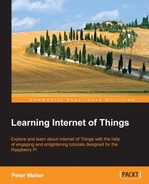Chapter 1, Preparing our IoT Projects, introduces the projects we will use throughout the book, their basic project structure, our development environment, how to prepare our Raspberry Pi, and how to perform basic input and output operations on it.
Chapter 2, The HTTP Protocol, presents the basics of the HTTP protocol and how it can be used in IoT applications. It also describes how it relates to the request/response and event subscription communication patterns.
Chapter 3, The UPnP Protocol, presents the basics of the UPnP protocol and how it can be used to discover devices in an ad hoc local area network. It also discusses how to call services on the devices and subscribe to events from them. Additionally, it describes how to build devices that publish such discoverable services and events.
Chapter 4, The CoAP Protocol, presents the basics of the CoAP protocol and how it can be used on devices that communicate over bandwidth-limited networks. It will show you how to publish content, how to subscribe to events, how to transport large content items using blocks, and how to discover existing resources on a device.
Chapter 5, The MQTT Protocol, introduces the MQTT protocol and shows how our IoT applications can bypass firewalls using the publish/subscribe communication pattern and message brokers.
Chapter 6, The XMPP Protocol, presents the XMPP protocol, and how it uses a federated set of message brokers to provide global identities and how it provides a richer set of communication patterns to the IoT developer. This chapter also introduces new communication patterns such as friendship authorization, presence subscription, asynchronous messaging, delegation of trust, and provisioning.
Chapter 7, Using an IoT Service Platform, presents reasons for using a service platform designed for IoT to facilitate rapid application development of IoT services and taking care of recurrent issues, such as security, interoperability, scalability, management, monitoring, and so on.
Chapter 8, Creating Protocol Gateways, shows you how to use good abstraction models to facilitate the creation of protocol bridges, allowing the interconnection of systems and services based on different technologies. This will enable you to design a secure and interoperable infrastructure for smart cities based on the IoT.
Chapter 9, Security and Interoperability, gives an overview of available threats and common modes of attack and how to build counter measures to protect your IoT solutions. It also shows the importance of interoperability in IoT and how to avoid limiting one to favor the other.
Appendix A, Console Applications, shows the basic structure of console applications, as used throughout the examples in this book.
Appendix B, Sampling and History, shows how sampling and historical record keeping of sensor values is done in the Sensor project published in this book.
Appendix C, Object Database, shows how to persist data in an object database, simply by using class definitions.
Appendix D, Control, shows how control operations are implemented in the Actuator project published in this book.
Appendix E, Fundamentals of HTTP, provides an overview of the fundamentals of the HTTP protocol.
Appendix F, Sensor Data Query Parameters, provides a set of query parameters we can use to limit readout requests from devices to data we are interested in.
Appendix G, Security in HTTP, discusses different ways to implement security into applications using the HTTP protocol.
Appendix H, Delayed Responses in HTTP, presents a method how to modify the request/response communication pattern used in HTTP to mimic the event subscription communication pattern.
Appendix I, Fundamentals of UPnP, provides an overview of the fundamentals of the UPnP protocol.
Appendix J, Data Types in UPnP, lists common data types used in UPnP.
Appendix K, Camera Web Interface, presents a simple web interface publishing pictures taken by the camera.
Appendix L, Text Encoding on the Web, discusses text encoding on the web, and possible encoding conflicts.
Appendix M, Sending Mail with Snapshots, shows how to send mail including embedded snapshots taken by the camera.
Appendix N, Tracking Cameras, shows how the controller application tracks available cameras in the network.
Appendix O, Certificates and Validation, gives a short description of how certificates work, and how to install certificates on the Raspberry Pi.
Appendix P, Chat Interfaces, shows how to add a chat interface to your devices, making it possible to chat with them using standard chat applications based on XMPP.
Appendix Q, QR Code, shows a simple way to generate and display QR code.
Appendix R, Bill of Materials, contains bills of materials containing the components used for the boards used in the examples in this book.
These Appendices are not present in the book but are available for download at the following link: https://www.packtpub.com/sites/default/files/downloads/3494_3532OT_Appendices.pdf
